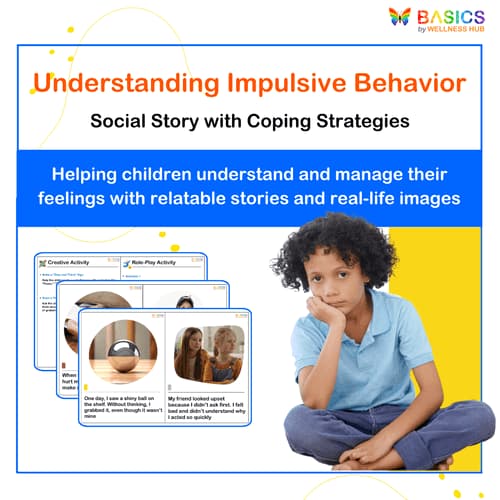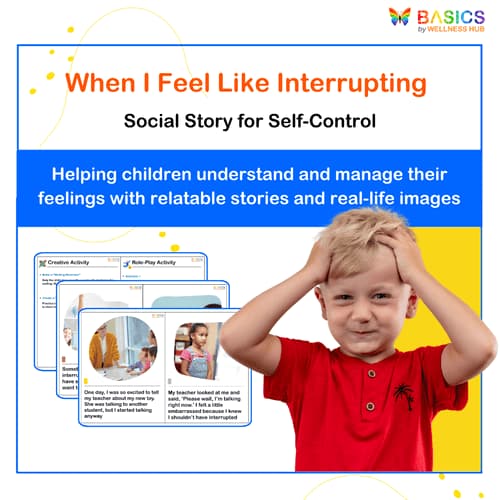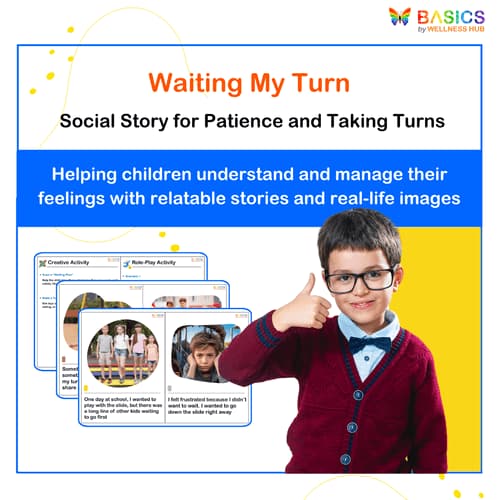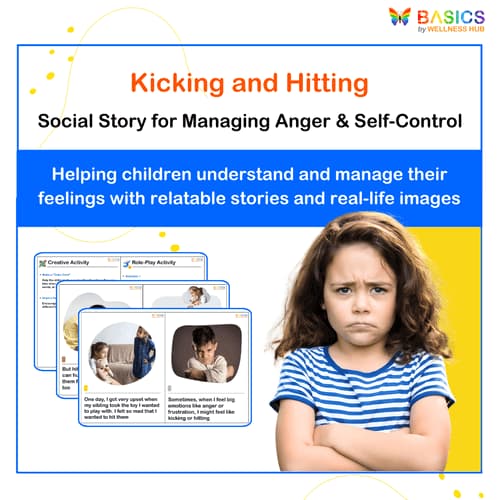





More and Less Flashcards: Teach Quantity Comparison with Everyday Objects
₹80
₹160
50% off
0 (0 ratings)
Grade Levels
Pre-K - Grade 1 (Ages 3-6)
Content Overview
Format: PDF, Total Pages: 12, Features: 48 pairs of more and less objects with high-quality illustrations.
Categories
Pages from the Resource
Help kids learn quantity comparison with our "More and Less Flashcards: Teach Quantity Comparison with Everyday Objects." This resource includes 48 pairs like "more bats, less bats" and "more flowers, less flowers," perfect for teaching children ages 3-6 the concepts of "more" and "less" using familiar, real-world examples.

Page 1

Page 2
What Users Say
0
0 ratings
5
0+
4
0+
3
0+
2
0+
1
0+
5 Stars
Product is Good to use.
10 months ago
Varsha Parent
Similar Products

Understanding Impulsive Behavior: Social Story with Coping Strategies
₹ 80.00
₹ 160.00
50% off
4.9 (42 ratings)

When I Feel Like Interrupting – Social Story for Self-Control
₹ 80.00
₹ 160.00
50% off
4.8 (60 ratings)

Waiting My Turn – Social Story for Patience and Taking Turns
₹ 80.00
₹ 160.00
50% off
4.7 (56 ratings)

Kicking and Hitting – Social Story for Managing Anger & Self-Control
₹ 80.00
₹ 160.00
50% off
4.6 (52 ratings)

Understanding Swear Words – Social Story for Respectful Communication
₹ 80.00
₹ 160.00
50% off
4.9 (48 ratings)
About the Product
Purpose of the Flashcards: The "More and Less Flashcards: Teach Quantity Comparison with Everyday Objects" resource is designed to introduce young learners to the fundamental concept of comparing quantities. Understanding the difference between "more" and "less" is an essential early math skill that builds a foundation for counting, addition, subtraction, and other mathematical operations. These flashcards provide a fun and engaging way to help children learn the concepts of "more" and "less" using familiar objects, making the learning experience both enjoyable and effective.
Target Audience: This resource is ideal for parents, early childhood educators, and special education professionals seeking an interactive tool to teach children ages 3-6 the concept of quantity comparison. The flashcards are versatile and can be used in individual learning sessions, group activities, or as part of a structured curriculum.
Product Details
Content Description: The set includes 48 pairs of objects designed to demonstrate the concepts of "more" and "less." The flashcards are organized into a 12-page high-quality PDF, with four pairs on each page. The pairs include everyday objects like bats, flowers, and rabbits, providing a clear and relatable visual representation of quantities. Each pair consists of one set with more objects and one set with fewer objects, labeled for easy recognition.
Image Quality and Design: The flashcards feature bright, high-resolution illustrations that are visually appealing and easy for young children to understand. The clean and simple design ensures that children can focus on the key concept of quantity comparison without any distractions.
Educational Benefits
Quantity Comparison and Early Math Skills: These flashcards introduce children to the fundamental math concepts of comparing quantities by focusing on "more" versus "less." Learning to distinguish between quantities helps build a foundation for future math skills such as counting, addition, and subtraction.
Cognitive Development: Associating objects with their quantities helps children develop cognitive skills like visual discrimination, pattern recognition, and logical thinking. The ability to compare quantities also strengthens critical thinking and decision-making abilities.
Language and Vocabulary Building: As children learn to describe objects based on their quantities (e.g., “more flowers” versus “less flowers”), they naturally expand their vocabulary and improve their descriptive language skills, setting a strong foundation for future language learning.
Critical Thinking and Categorization: The flashcards encourage children to group objects based on shared characteristics, which aids in developing critical thinking, organizational skills, and the ability to recognize patterns.
Instructions for Use
Printing Recommendations: For optimal durability and clarity, print the flashcards on thick, glossy cardstock. This ensures that the images remain vibrant and that the cards can withstand frequent use in both classroom and home settings.
Cutting and Preparation: Carefully cut the flashcards along the indicated lines to separate each pair. Laminating the flashcards is recommended, especially if they will be used regularly in a classroom or therapy setting, as it enhances their durability.
Utilization Tips:
Introduction and Familiarization: Begin by introducing a few simple pairs (e.g., "more bats, less bats") to help children become familiar with the concept of quantity comparison. Gradually introduce more pairs as the child becomes comfortable with the initial set.
Interactive Games: Use the flashcards in sorting games where children group the cards into "more" and "less" categories. This reinforces the learning of quantity comparison in an engaging and interactive way.
Real-Life Object Comparisons: Reinforce learning by encouraging children to find real-life examples of "more" and "less" objects around them. For instance, they can compare a bowl with more apples versus a bowl with fewer apples, helping them connect the concepts to everyday life.
Group Learning: The flashcards can be used in group activities where children take turns identifying which set of objects has "more" or "less," promoting both cognitive development and social interaction.
Activities Using the Resource
Sorting Game: Lay out the flashcards and ask children to sort them into two groups: one group with more objects and another group with less. For example, group “more bats” together and “less bats” together. This activity reinforces the concept of comparing quantities while helping children practice categorization skills.
Matching Pairs Game: Mix the flashcards and have children match pairs of objects that are the same but differ in quantity. For instance, they can match "more rabbits" with "less rabbits" and explain which group has more or fewer objects. This interactive activity helps build memory and recognition skills while emphasizing quantity comparison.
Real-Life Quantity Hunt: After introducing the flashcards, engage children in a scavenger hunt around the house or classroom. Ask them to find real-life examples of "more" and "less" objects that correspond to the flashcards. For instance, they can compare a pile of more toys versus a pile with fewer toys. This activity connects the learning from the flashcards to real-world experiences and makes the concept more relatable.
Storytelling with Quantities: Encourage children to create stories using the "more" and "less" object pairs. For example, a story might involve “more flowers in the garden” versus “less flowers in the vase.” This activity reinforces comparison concepts while fostering creativity and language development.
Memory Match Game: Place the flashcards face down and have children flip them over two at a time to find matching pairs, either "more" or "less." This game improves memory and concentration while reinforcing quantity comparison concepts.
Group Activity – Quantity Comparison Race: In a group setting, lay out multiple pairs of flashcards and have children race to find and sort all the "more" objects in one pile and "less" objects in another. This can be a fun and engaging way for kids to learn through movement and play.
FAQs
Q1: Are these flashcards suitable for children just beginning to learn about quantity comparison?
A1: Yes, these flashcards are perfect for beginners as they introduce quantity comparison in a simple, easy-to-understand format using familiar objects.
Q2: How can I ensure that the flashcards remain durable over time?
A2: We recommend printing the flashcards on thick cardstock and laminating them. This makes them sturdy and capable of withstanding frequent use, especially in classroom or therapy settings.
Q3: Can these flashcards be used in group learning activities?
A3: Absolutely! These flashcards are versatile and can be used in both individual and group settings. They are ideal for classrooms, homeschooling, and therapy sessions.
Q4: How many flashcards should I introduce at a time?
A4: Start with a few pairs featuring familiar objects (e.g., “more bats, less bats”) and gradually introduce more pairs as the child becomes comfortable with the initial set.
Q5: Are these flashcards suitable for children with special needs?
A5: Yes, the clear visuals and simple concept of quantity comparison make these flashcards highly effective for children with sensory processing or cognitive delays.
Q6: Can I customize the order of the flashcards to suit different learning levels?
A6: Absolutely! You can tailor the flashcards to the child’s learning level by starting with easier pairs and gradually introducing more challenging comparisons as they progress.
Usage Rights and Restrictions
Usage Guidelines: These flashcards are intended for personal and educational use only. Purchasers may print and use them in a single home or classroom setting. The digital file and printed copies cannot be shared, redistributed, or sold. Unauthorized commercial use, mass distribution, and sharing outside of the purchaser’s environment are prohibited.
Conclusion
Thank you for choosing 'More and Less Flashcards: Teach Quantity Comparison with Everyday Objects.' We hope this resource helps build a solid foundation for your child’s early math and cognitive skills. Whether used at home, in the classroom, or during therapy sessions, these flashcards are designed to make learning engaging and effective. We wish you and your young learners much success on your educational journey!



